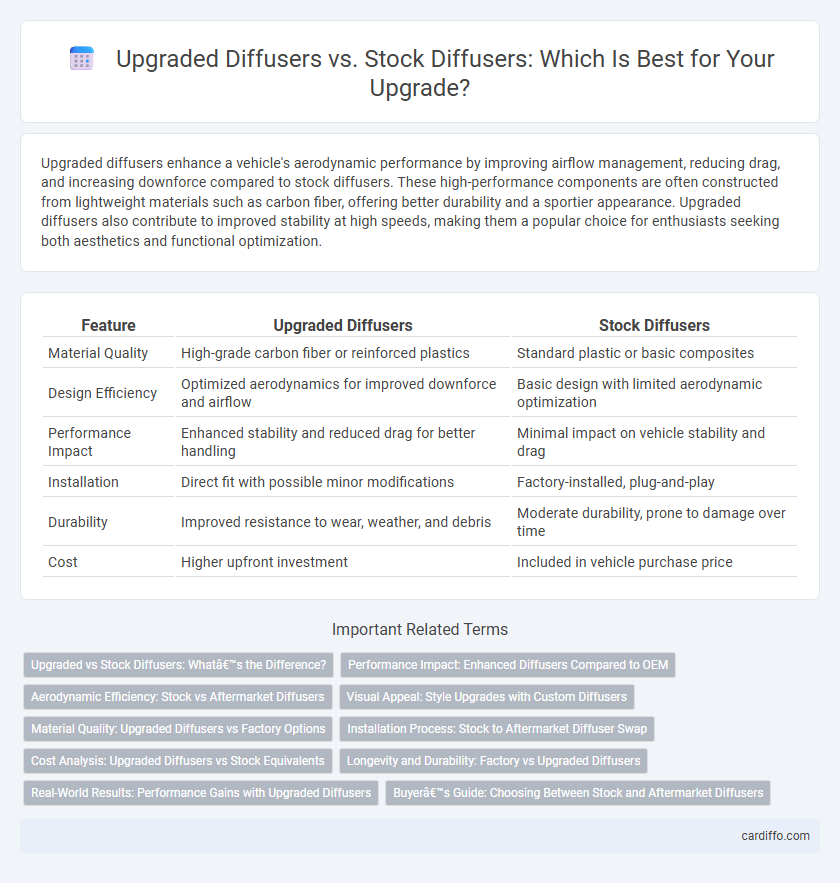Upgraded diffusers enhance a vehicle's aerodynamic performance by improving airflow management, reducing drag, and increasing downforce compared to stock diffusers. These high-performance components are often constructed from lightweight materials such as carbon fiber, offering better durability and a sportier appearance. Upgraded diffusers also contribute to improved stability at high speeds, making them a popular choice for enthusiasts seeking both aesthetics and functional optimization.
Table of Comparison
| Feature | Upgraded Diffusers | Stock Diffusers |
|---|---|---|
| Material Quality | High-grade carbon fiber or reinforced plastics | Standard plastic or basic composites |
| Design Efficiency | Optimized aerodynamics for improved downforce and airflow | Basic design with limited aerodynamic optimization |
| Performance Impact | Enhanced stability and reduced drag for better handling | Minimal impact on vehicle stability and drag |
| Installation | Direct fit with possible minor modifications | Factory-installed, plug-and-play |
| Durability | Improved resistance to wear, weather, and debris | Moderate durability, prone to damage over time |
| Cost | Higher upfront investment | Included in vehicle purchase price |
Upgraded vs Stock Diffusers: What’s the Difference?
Upgraded diffusers utilize advanced materials and aerodynamic designs to enhance airflow management and reduce drag compared to stock diffusers, resulting in improved vehicle stability and handling at high speeds. Unlike stock diffusers, which are often designed for basic functionality and cost efficiency, upgraded versions feature optimized vent geometry and reinforced construction to withstand more rigorous driving conditions. The performance gains from upgraded diffusers translate into increased downforce and better overall vehicle dynamics, particularly noticeable during cornering and high-speed acceleration.
Performance Impact: Enhanced Diffusers Compared to OEM
Upgraded diffusers significantly improve aerodynamic performance by optimizing airflow and increasing downforce compared to stock diffusers, resulting in better vehicle stability at high speeds. Enhanced diffusers, often constructed from lightweight, durable materials like carbon fiber, reduce drag and improve cooling efficiency for brake and drivetrain components. These performance gains contribute to quicker lap times and more responsive handling, making upgraded diffusers a critical modification for track-focused vehicles.
Aerodynamic Efficiency: Stock vs Aftermarket Diffusers
Upgraded diffusers enhance aerodynamic efficiency by optimizing airflow under the vehicle, reducing drag and increasing downforce compared to stock diffusers that often have basic designs with limited airflow management. Aftermarket diffusers utilize advanced materials and precise contours to improve air pressure distribution, resulting in better stability at high speeds and improved fuel efficiency. This aerodynamic refinement contributes to superior handling and performance advantages over standard stock diffusers.
Visual Appeal: Style Upgrades with Custom Diffusers
Upgraded diffusers significantly enhance the visual appeal of a vehicle by offering sleek, aerodynamic designs and premium finishes that surpass stock options. Custom diffusers often feature carbon fiber or matte textures, creating a sporty and aggressive look that complements aftermarket body kits. These style upgrades not only improve aesthetics but also give the car a unique, personalized appearance that stands out from factory-standard models.
Material Quality: Upgraded Diffusers vs Factory Options
Upgraded diffusers typically utilize high-grade materials such as carbon fiber or reinforced ABS plastic, offering enhanced durability and heat resistance compared to stock diffuser options made from standard plastic composites. The superior material quality in upgraded diffusers increases longevity and maintains aerodynamic performance under extreme conditions. Factory stock diffusers often prioritize cost-efficiency, resulting in thinner, less robust materials that may degrade faster over time.
Installation Process: Stock to Aftermarket Diffuser Swap
Upgrading from stock diffusers to aftermarket versions involves a straightforward installation process that typically requires minimal modifications to the vehicle's bumper. Aftermarket diffusers often come with pre-drilled holes or mounting points that align with the factory setup, simplifying the swap and reducing installation time. This upgrade enhances aerodynamic performance and visual appeal without demanding extensive technical expertise or specialized tools.
Cost Analysis: Upgraded Diffusers vs Stock Equivalents
Upgraded diffusers typically offer enhanced airflow efficiency and durability but come at a higher initial cost compared to stock diffusers, which are usually more affordable but less optimized for performance. The long-term investment in upgraded diffusers can lead to energy savings and reduced maintenance expenses due to superior materials and design. Cost analysis reveals that despite the upfront premium, upgraded diffusers often provide better value through improved operational efficiency and extended lifespan.
Longevity and Durability: Factory vs Upgraded Diffusers
Upgraded diffusers typically feature enhanced materials such as reinforced polycarbonate or carbon fiber composites, significantly increasing their resistance to impact and wear compared to stock diffusers made from standard ABS plastic. The longevity of upgraded diffusers surpasses factory versions by maintaining structural integrity and appearance under harsh environmental conditions like UV exposure and temperature fluctuations. This durability ensures that upgraded diffusers provide a longer service life and better sustained aerodynamic performance for the vehicle.
Real-World Results: Performance Gains with Upgraded Diffusers
Upgraded diffusers deliver measurable performance gains by optimizing airflow and reducing drag compared to stock diffusers, resulting in improved downforce and vehicle stability at high speeds. Real-world testing shows enhanced cornering grip and faster lap times, with some upgrades producing up to a 15% increase in aerodynamic efficiency. These improvements translate into tangible benefits for both street driving and track performance, highlighting the value of investing in quality diffuser upgrades.
Buyer’s Guide: Choosing Between Stock and Aftermarket Diffusers
Upgraded diffusers offer enhanced aerodynamic performance by improving airflow and increasing downforce compared to stock diffusers, making them ideal for enthusiasts seeking better handling and stability. Stock diffusers provide a cost-effective and factory-tested option with reliable fitment and durability, suitable for everyday driving needs. When choosing between stock and aftermarket diffusers, consider factors such as material quality, design efficiency, installation complexity, and your primary driving goals to ensure optimal vehicle performance and aesthetics.
upgraded diffusers vs stock diffusers Infographic

 cardiffo.com
cardiffo.com